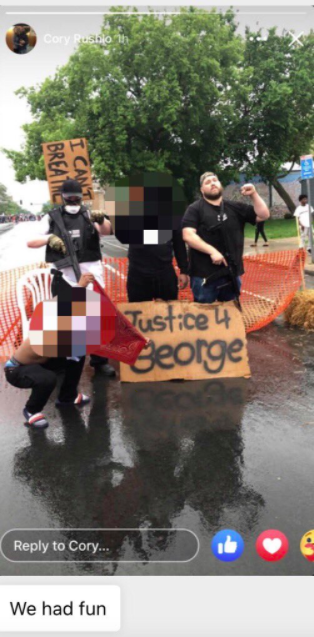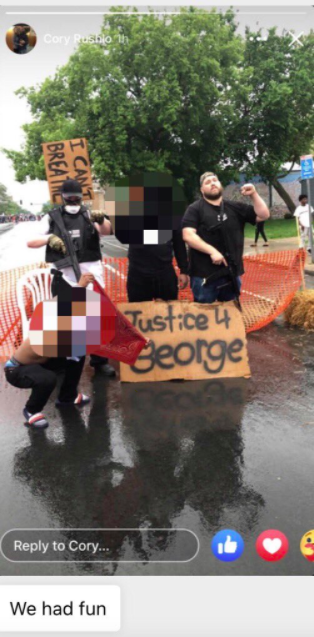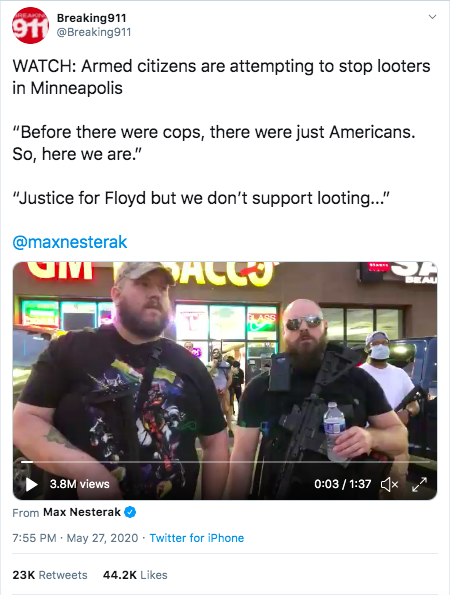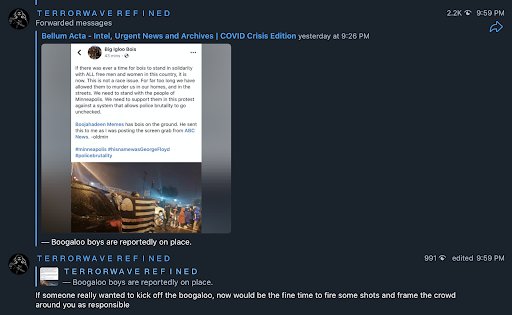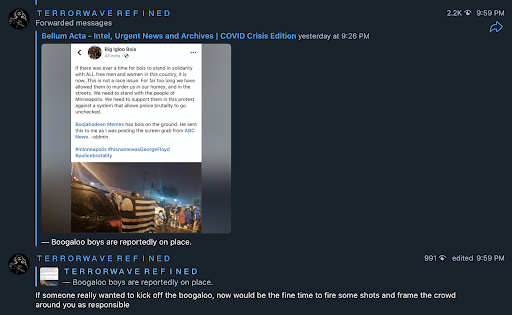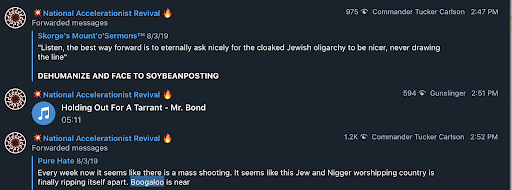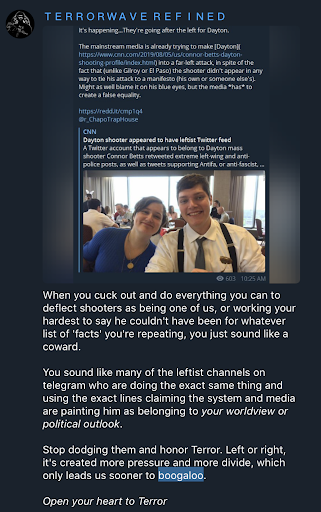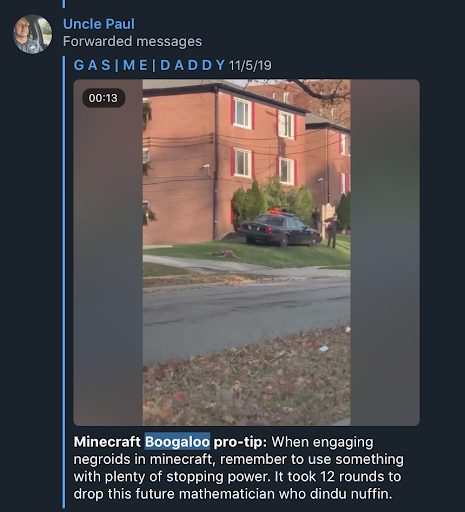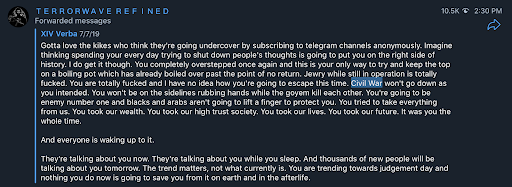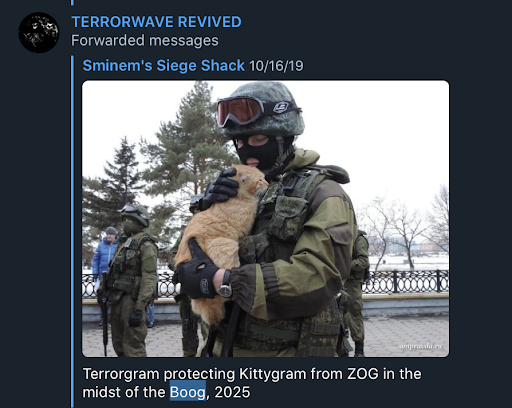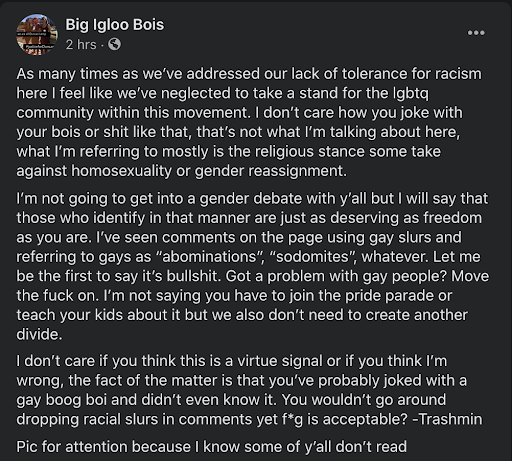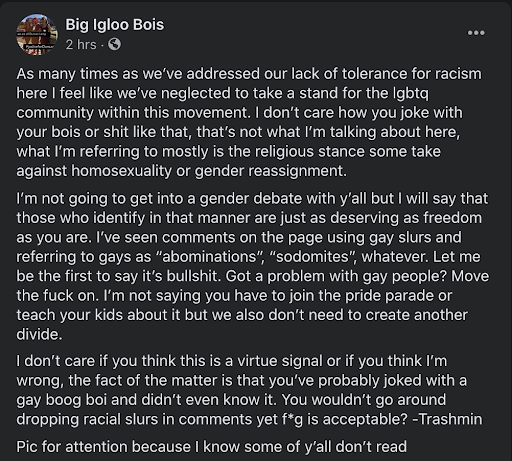The Boogaloo Movement Wants To Be Seen as Anti-Racist, But It Has a White Supremacist Fringe
| by Alex Newhouse and Nate Gunesch
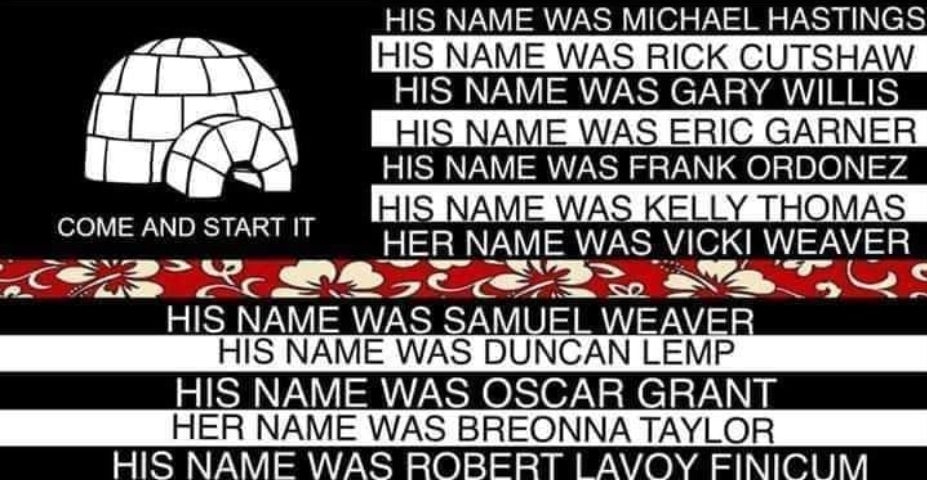
On May 25, 2020, a black man named George Floyd was killed by a white police officer in Minneapolis, MN. One day later, protests and riots broke out around the city, as civilians gathered to express anger and discontent at the mistreatment and ultimate death of Floyd, which was captured on video by a bystander. The protests largely arose organically, with some assistance from Black Lives Matter (BLM) and antifascist collectives. As the protests grew in intensity and violence, other groups took notice. In particular, dramatic livestreams and videos of confrontations between black civilians and police officers caught the attention of the so-called Boogaloo Movement, a right-wing militia-style movement that is convinced of either an imminent American civil war, a revolution, or a violent anti-government resistance.
Now, as protests spread throughout the United States and occasionally break out in violence, the self-proclaimed “Boogaloo Bois” have started appearing more frequently in multiple cities.
The Boogaloo (also known as the Big Luau, the Big Igloo, or the Bungalow) is seen as the breaking point where government oppression is finally met with revolutionary violence from armed citizens. According to posts across Facebook, Telegram, and Twitter, many “Boogaloo Bois” see the protests as the catalyst that will finally begin the violent upheaval they crave. Adherents promote a race-neutral conception of a revolution, predicting a grand alliance between right libertarians, anarchists, and Black nationalists that will achieve victory and overthrow the government. During the first two days of protests, a small number of Boogaloo Bois—white, male, heavily armed, and clad in Hawaiian shirts—deployed to the streets of Minneapolis. They vocally supported the protestors, but they primarily focused on confronting the police.
The Boogaloo Movement is far from united in support of this new idea of allying with BLM and antifascists against the government. Some within the movement have expressed skepticism, outright racism, and notions of white supremacy in response to various large Boogaloo social media pages expressing solidarity with the protesters. Others note that antifascist and leftist social media accounts have urged that protesters exercise caution around Boogaloo Bois. Few, if any, recognize that their own focus with anti-government accelerationism, penchant for firearms, and the history of their movement have made them vulnerable to the influence of the extreme right. In this investigation, CTEC tracks the efforts of Boogaloo Bois to forge a multi-racial anti-government movement, the limitations of anti-authoritarian solidarity, and the exterminationist fringe at the corners of the movement that may make such a coalition impossible.
The Origins of the Boogaloo Movement
The term “boogaloo” originates from the title of an 80s film, “Breakin’ 2: Electric Boogaloo.” It has been used in Internet memes for far longer than the current incarnation. In its general form, the term is applied to sequels of virtually anything and emerged in the mid-2000s. However, in recent years, it has caught on among far-right militia and white supremacist communities who use it to refer to what they foresee as a coming revolution: “Civil War 2: Electric Boogaloo.”
According to reporting from Bellingcat and CTEC’s own investigation of 4chan archives, this new meme emerged nearly simultaneously within pro-Second Amendment and racist communities. The Boogaloo Movement specifically grew out of 4chan’s firearms-focused message board /k/, but the meme itself grew organically on the racist board /pol/, due to significant user overlap between the two communities. In 2018 and 2019 these discussions moved from 4chan to Facebook and organized in groups with names like “Big Igloo Bois,” “Boojahideen Memes,” and “Big /K/ahuna’s Big Luau.”
These variations on the term Boogaloo have emerged as signals to the broader movement and as attempts to evade possible content moderation. Dozens of active Facebook groups now participate in furthering the Boogaloo meme and the movement, with posters variously calling for political upheaval and revolution. Particularly violent and threatening memes target police officers, political elite, and other perceived members of the state. [1, 2, 3, 4]
Self-proclaimed “Boogaloo Bois” broke into mainstream news in early 2020 with high-profile protests against gun control legislation and COVID-19 shelter-in-place policies. [5, 6] Boogaloo Bois often stand out from crowds due to their uniform of body armor, heavy weaponry, and Hawaiian shirts. As a symbol for the movement, the shirts stem from the term “Big Luau” and the association of Luaus with pig roasts, which is appealing to Boogaloo Bois as they often call police “pigs.” [7]
The Boogaloo Movement has tried, to varying levels of success, to distinguish itself from other far-right groups. In ideology, they generally share more in common with the Patriot Movement from the 1990s and early 2000s than to contemporary alt-Right or white nationalist movements. [8]
Boogaloo Activity During the Protest
Facebook users active in the Boogaloo movement saw the protests in Minneapolis that began May 26 as a possible catalyst for revolution, upheaval, even a civil war, based not on racial tensions but on anti-government and anti-police resistance. Within the Boogaloo movement, gun ownership and individual liberty generally precede white supremacist and neo-Nazi sentiments, and many Facebook groups make a point of disavowing racism and National Socialists (“Natsocs”). [9, 10, 11] Administrators of pages such as Big Igloo Bois and Boojahadeen Memes actively supported the anti-racist and Black Lives Matter protests. They adopt a combination of serious moral tirades against police brutality and government capriciousness with memes and images typical of informal political groups. The Boogaloo movement claims a distinctly non-racial approach to anti-government action. As an example, affiliates on Facebook share images supporting gun ownership in African-American communities as a means of defense against abuses by police. Similarly, these Facebook groups draw clear parallels between George Floyd and figures of libertarian and gun-rights movements who have been killed by police in the past. [12]
During the protests, members of Boogaloo Movement Facebook groups exchanged information about police activities. Journalist Robert Evans detailed on Twitter the manner in which Boogaloo groups on Facebook hyped the protests as the start of the “boog.” Throughout the evening, photos circulated of individuals at the protest carrying flags associated with the Boogaloo movement. [13] Facebook pages associated with the Boogaloo movement called on members to stand with protestors in Minneapolis and fight the police. On May 26, the Big Igloo Bois page claimed that 16 Boogaloo supporters showed up to protest and engage with police, and that one among them was struck by a rubber bullet. [14, 15, 16]
CTEC’s investigation of social media evidence and reports from journalists on May 26 suggested that at least a few Boogaloo Movement supporters were present, although likely not as many as 16. Though Boogaloo supporters did not make a significant show of force, they were active online. Many expressed sympathy for the protestors and offered tactical advice for those who attended the protest. [17] Some discussed capturing a police station and pages posted photos of the damage to police cruisers and standoffs with officers, indicating the desire to harm and kill police.
Reports of armed white men in masks made antifascist and BLM protestors nervous—reports even circulated of efforts to disarm a white man with a handgun, who was variously described as a white nationalist or a Boogaloo Boi. [18] Antifascist groups on Twitter expressed concerns about unknown allies, particularly those who frequent alt-right mainstream and fringe social media accounts. [19, 20] On Facebook, Boogaloo supporters debated the best way to express sympathy for the protestors. Some worried that BLM protestors would distrust the Boogaloo Bois, while others insisted that fighting police would demonstrate to BLM activists that they and the Boogaloo Bois were on the same side. Again, serious discussions took place alongside memes like the one shown below.
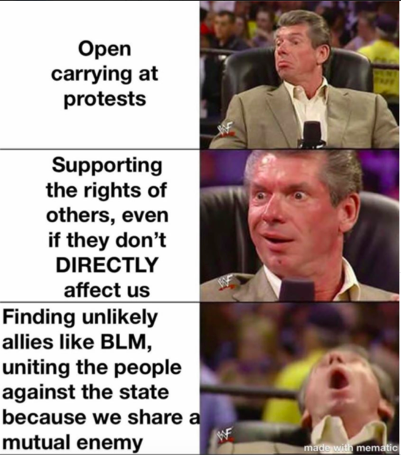
Although Boogaloo Bois took only minor direct action on May 26, many on Facebook commended a supporter who called authorities to inform them that a black man—allegedly targeted by police who reported that he carried a gun—was, in fact, unarmed. On May 27, video and photos surfaced of two armed Boogaloo Bois guarding a tobacco store from looters and posing with BLM protesters. Antifascist groups on Twitter later identified the men, and at least one had taken part in the protests the night before. [21] In the video, the two men express sympathy for the protestors as well as anti-police sentiments and frequently use the phrase “Justice for Floyd,” while simultaneously noting a desire to see the looting stop. In line with online Boogaloo activity, the men suggested that they were there to support individual liberties where law enforcement officials fell short. Boogaloo Movement Facebook pages supported the two men’s activity.
However, the ultimate lack of direct violent confrontation with the police or government—no “boog” began in Minneapolis on the evening of May 26—is emblematic of a broader frustration within the Boogaloo movement. Though the group is unified by anti-government sentiments, some members express anger that their fantasy of a “civil war” has not manifested. Commenters often criticize each other for a lack of action with one suggesting his fellow “bois” should put down the “LARPing” (Live Action Role Playing) gear and act. Other posters continued to try to incite Boogaloo Bois to commit violence with one writing on May 26, “Time to start the boog. Civvies are pretty much out of the area.” Boogaloo Bois frequently share this sentiment, expressing a desire to attack police while avoiding harm to civilians and private property. [22]
Similarly, on the evening of May 27, the Facebook page Boojahadeen Memes shared maps with rudimentary drawings depicting police movements and active fires. Many on social media appeared to track police scanners and provide updates according to the information they heard, though their activity remained online. While Boogaloo Facebook pages were active in their discussion of violence against police, few members attended the protest and none seem to have attacked law enforcement officers. [23, 24]
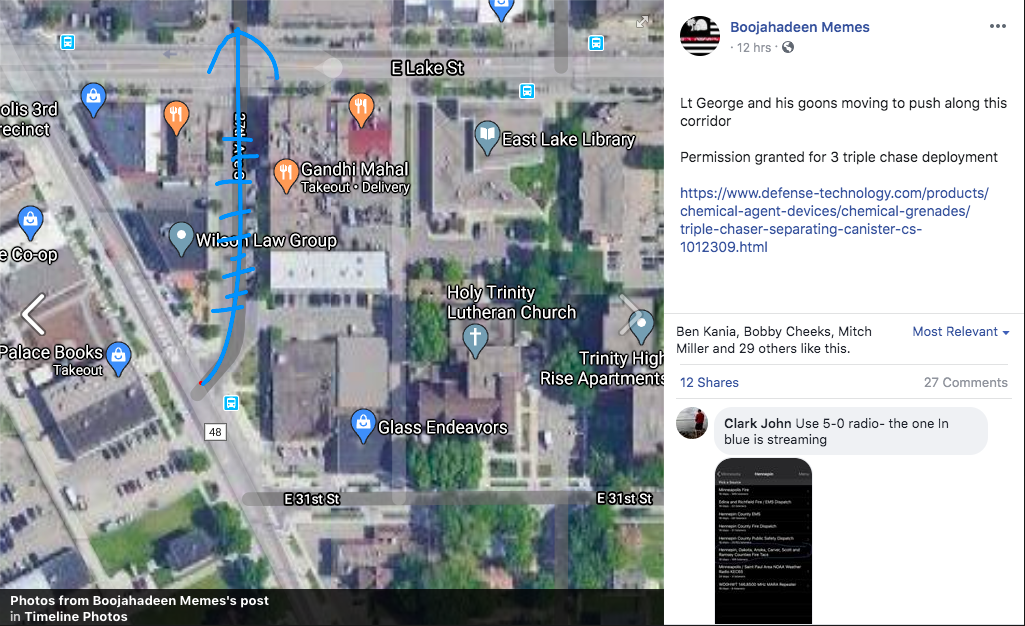
By May 27-28, stark divisions had appeared in the Boogaloo Movement in response to the escalating violence of the protests. While commenters and administrators still cheered on confrontations with police officers and the destruction of police property, pages increasingly focused on condemning looting and destruction of business property. Big Igloo Memes, for example, celebrated the Boogaloo Bois who were on the ground in Minneapolis to defend a small tobacco shop. [25] However, the page administrator’s attempts to empathize with rioters went too far for some commenters, who strongly objected to looting and destruction of small business. [26, 27, 28] Many also supported President Trump’s apparent call to shoot looters. [29] This tension represents the inner turmoil of the Boogaloo Movement, a movement that has its roots in private property-focused right-wing libertarianism. These roots therefore pose obstacles to supporters attempting to pivot toward more universalist anti-government activism. Nevertheless, an even more intractable challenge is the white supremacists and neo-Nazis who also crave the boogaloo.
White Supremacist Accelerationism
As protests wore on and antifascist and BLM protesters continued to resist attempts at solidarity from Boogaloo Bois, members of the Boogaloo Facebook groups began expressing frustration and, in some cases, outright anger. Much of this anger has been directed at the administrators of the largest Boogaloo pages who have continued to distance themselves from white supremacy and even pro-civil war rhetoric as they have gained greater mainstream attention. [30, 31, 32] However, although Boogaloo Boi communities have gone to great lengths to disavow racism, their ideology nonetheless brings them into close proximity with some of the most fringe and explicitly neo-Nazi parts of the Internet.
The biggest obstacle facing anti-racist Boogaloo Bois is that they have not monopolized the Boogaloo movement or the Boogaloo meme. As reported by the Anti-Defamation League and Bellingcat, the movement and the meme have been embraced by white supremacist and neo-Nazi accelerationists.
Tensions arise between Boogaloo Bois and white supremacists due to their mutual embrace of accelerationism, a philosophy that has its roots in extreme Marixst thought. Accelerationists historically have sought out what they perceive as capitalism’s most exploitative trends, because they see these trends as exacerbating social divisions that can cause disruption. This disruption, if widespread and violent enough, will theoretically lead to the collapse of the social order. Although modern-day accelerationism exists across the political spectrum, it has become associated with high-profile cases of white supremacist violence. Brenton Tarrant, who committed a mass shooting in Christchurch, New Zealand, advocated for accelerationism. Far-right terrorist and extremist groups cast Tarrant’s manifesto as a nearly biblical work, and accelerationist communities occasionally use Tarrant as a meme, even in their titles.
Anti-government accelerationists like the Boogaloo Bois view the protests as an expression of rage against tyranny, which sheds light on why so many Boogaloo communities have been expressing explicit solidarity with the Black Lives Matter movement. White supremacist accelerationists, on the other hand, view events like the Minneapolis protests as a way to lean on racial divisions in order to spark the “racial holy war,” which will, in right-wing lore, bring about the collapse of liberal degeneracy and usher in the reclamation of white dominance. This concept has developed into a meme among far-right groups with the use of slogans like “RaHoWa” (Racial Holy War) and “GTK RWN” (Gas the Kikes, Race War Now). The latter has been used as a slogan for the Atomwaffen Division. White supremacists view BLM and antifascists as pawns needed to spark the race war to be disposed of immediately once it has begun.
CTEC’s review of 4chan archives reveals a long history of accelerationist overlap between the more libertarian /k/ and the more white supremacist /pol/ message boards. From at least 2013 on, /pol/ users have both humorously and seriously embraced apocalyptic millenarianism. For example, “Boogaloo” was preceded by “The Happening,” which referred to any sort of large-scale violent conflict, from uprisings to nuclear war. In the /pol/ ecosystem, “The Happening” has a mystical allure and generally refers to Turner Diaries-esque race war. Countless posts on /pol/ even use “The Happening” and “The Day of the Rope” interchangeably. [33]
/pol/’s desire for race war is inextricably linked to the development of the Boogaloo Movement on /k/. For years, users have directed others to /k/ to build their knowledge of firearms and heavy weaponry, to choose on a weapon to buy, and to bolster their understanding of rebellion tactics. [34, 35, 36, 37, 38] For its part, /k/ has routinely engaged with /pol/ to seriously discuss the armor and weapons needed to succeed in the Boogaloo, such as discussing the relative merits of tanks and armored vehicles in an insurrection. [39] Although less united in white supremacy (/k/ users, on occasion, attempt to distance the Boogaloo from race war), Boogaloo threads nonetheless frequently include anti-Semitic and racist calls to violence. [40]
The connection between the Boogaloo meme and white supremacist accelerationists has gone beyond 4chan, as well. In the past few years, exterminationist communities have largely congregated on Telegram, an encrypted, mostly unregulated social media app that has become a haven for groups and individuals who have been banned by mainstream platforms. Collectively referred to as “Terrorgram,” these public white supremacist and fascist channels have thousands of subscribers and promote racial versions of the Boogaloo. Terrorgram channels include Boogaloo channels in their ranks; cross-promotional posts by overt neo-Nazi channels have amplified the most popular Boogaloo in the past. In addition, during protests in Dallas on May 29, an owner of a Terrorgram-adjacent channel appeared in body armor and wielding a rifle. This man, who goes by the handle WarHippie, was tracked by Left Coast Right Watch and later identified by an antifascist collective, posted violent, racist, and anti-Jewish content alongside invocations of the Boogaloo meme. [41]
This linguistic and ideological proximity has caused problems for Boogaloo pages in the past, as demonstrated on May 11, when Big Igloo Bois publicly stated that they would not welcome Natsocs, and proclaimed that they will target racists first during the Boogaloo. They even posted a meme embracing violence against Natsocs. [42] In the comments, followers generally supported the race-neutral sentiment, but many responded with accusations of “virtue signalling” and denial of the Natsoc roots of the Boogaloo movement. One commenter in the top thread attempted to direct the conversation toward targeting Jews as the ultimate manipulators of world tragedies.
A more recent example, from May 27, occurred when Big Igloo Bois attempted to disavow homophobia and transphobia, taking a public stand against the use of anti-LGBTQ slurs. [43] The page’s admin actually embraced trans and gay people as allies in the Boogaloo. This caused significant conflict among the page’s followers, many of whom have now expressed disillusionment with such universalist accelerationism.
In recent weeks, as the Boogaloo Movement has grown in profile, groups have attempted to define what the “Boogaloo” means in order to distance themselves from pro-civil war rhetoric. These groups state the “Boogaloo” refers to forcing the government to respect the First Amendment by staging heavily armed protests. [44] As the administrator of Big Igloo Bois wrote on May 26, “We do not want a civil war. For the most part we want to be left the fuck alone. We want an end to the increasingly oppressive police state. We want an end to representatives who only represent themselves, while stripping us of our civil liberties. We want an end to the notion that this is a movement for guns. The guns are the only reason this movement is allowed to exist. It is far more difficult to subjugate an armed citizen. This idea of civil war, of violence, is being foisted upon us.” [45]
In spite of these posts, the Boogaloo meme clearly originated from the concept of accelerating toward violent rebellion, revolution, and/or civil war, and it emerged in tandem with more fringe racist millenarianism on 4chan and Telegram. While they may narrowly reject “civil war,” both the Big Igloo Bois and Boojahadeen Memes have in the past directly advocated for armed insurrection against the state. [46, 47] Boogaloo Bois have discovered that their supposed allies—Black Lives Matter and antifascist protesters in Minneapolis, primarily—have responded with wariness, hostility, and outright derision to the appearance of Hawaiian shirt-wearing, heavily armed white men in their midst. In spite of some efforts, this wariness from protestors and the left-wing will likely continue as long as white supremacist accelerationists are promoting their own concept of the Boogaloo—and as long as the white supremacists continue to view the Boogaloo Bois as either pawns or allies in their advocacy for a race war.

